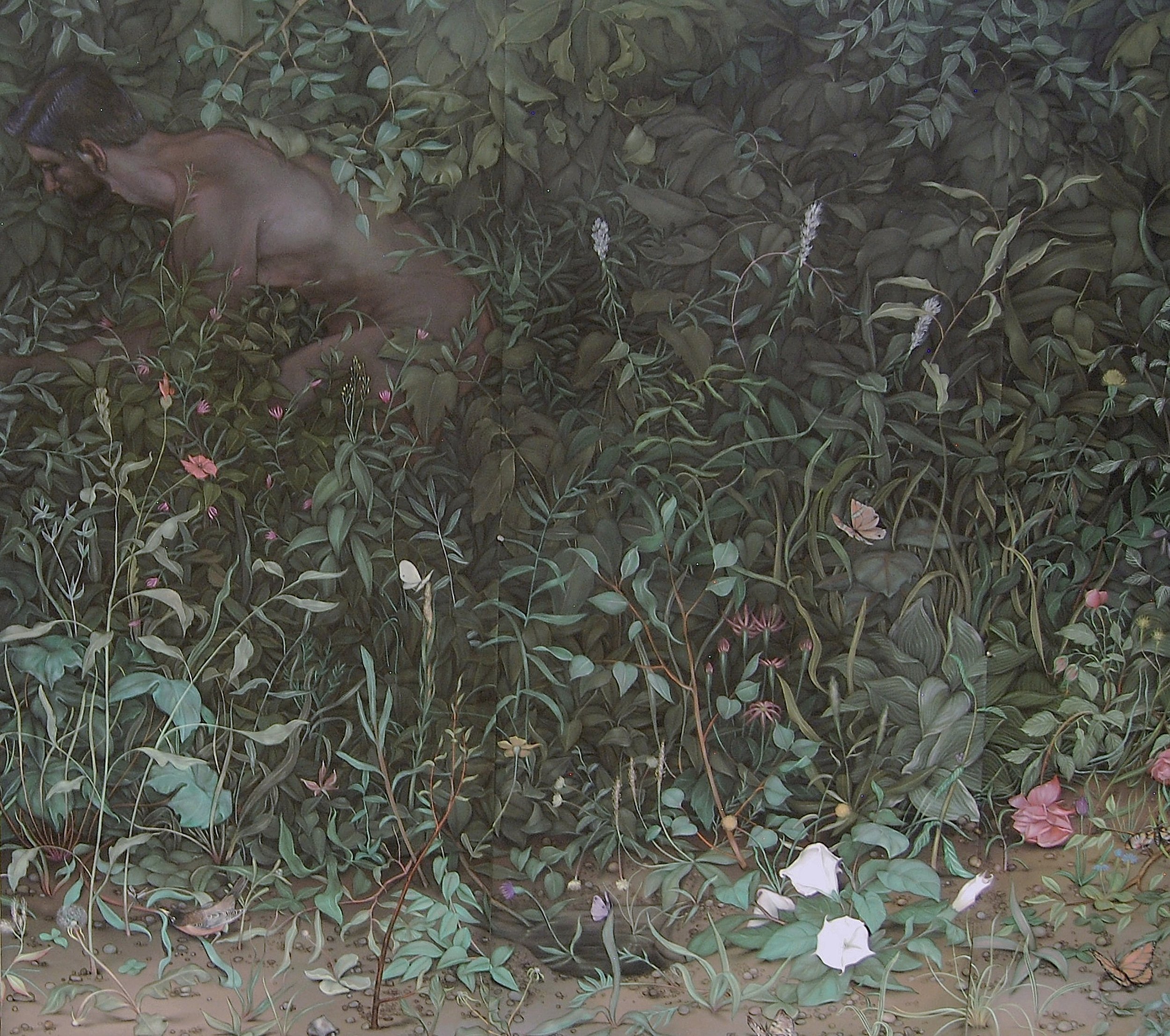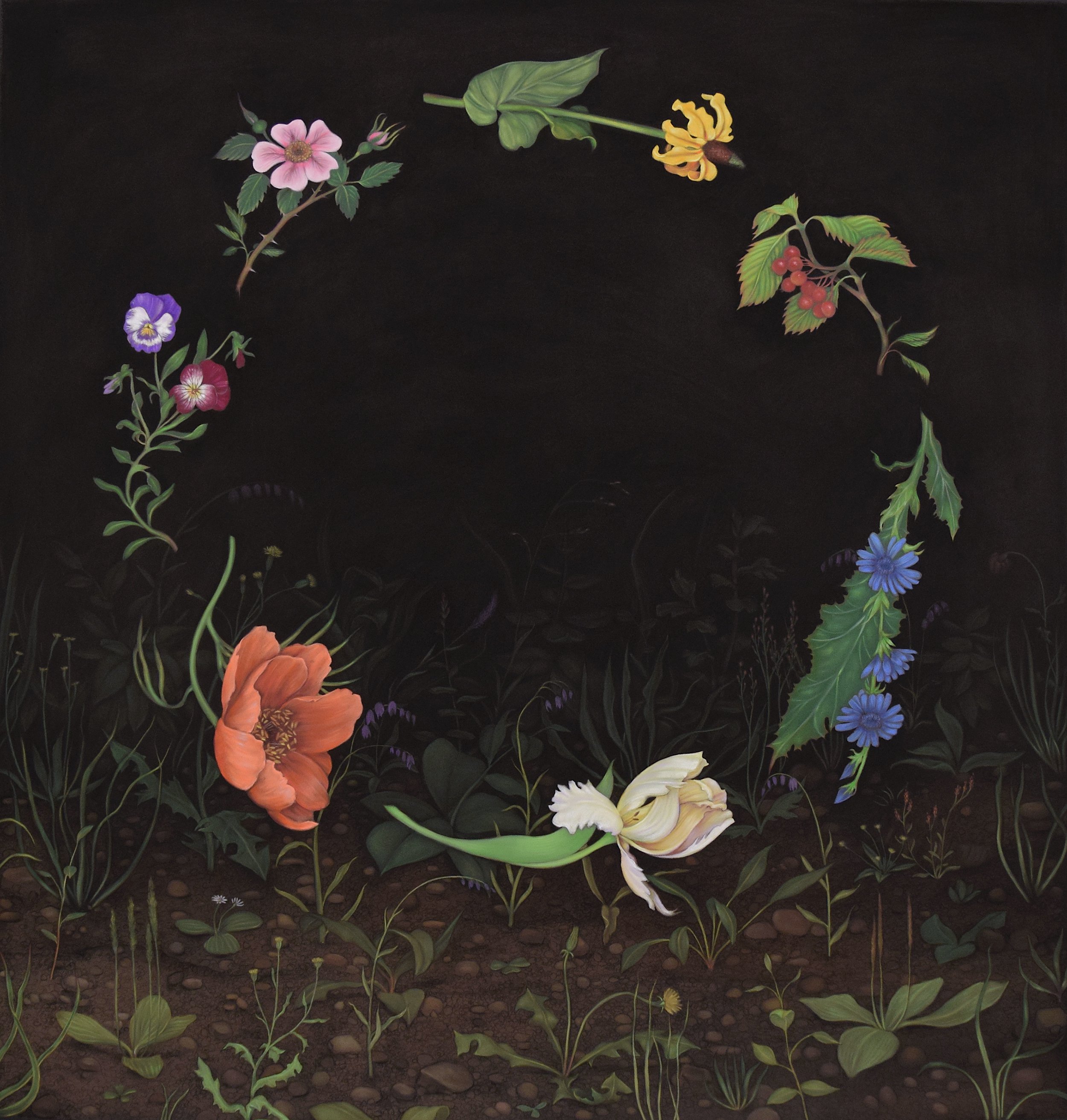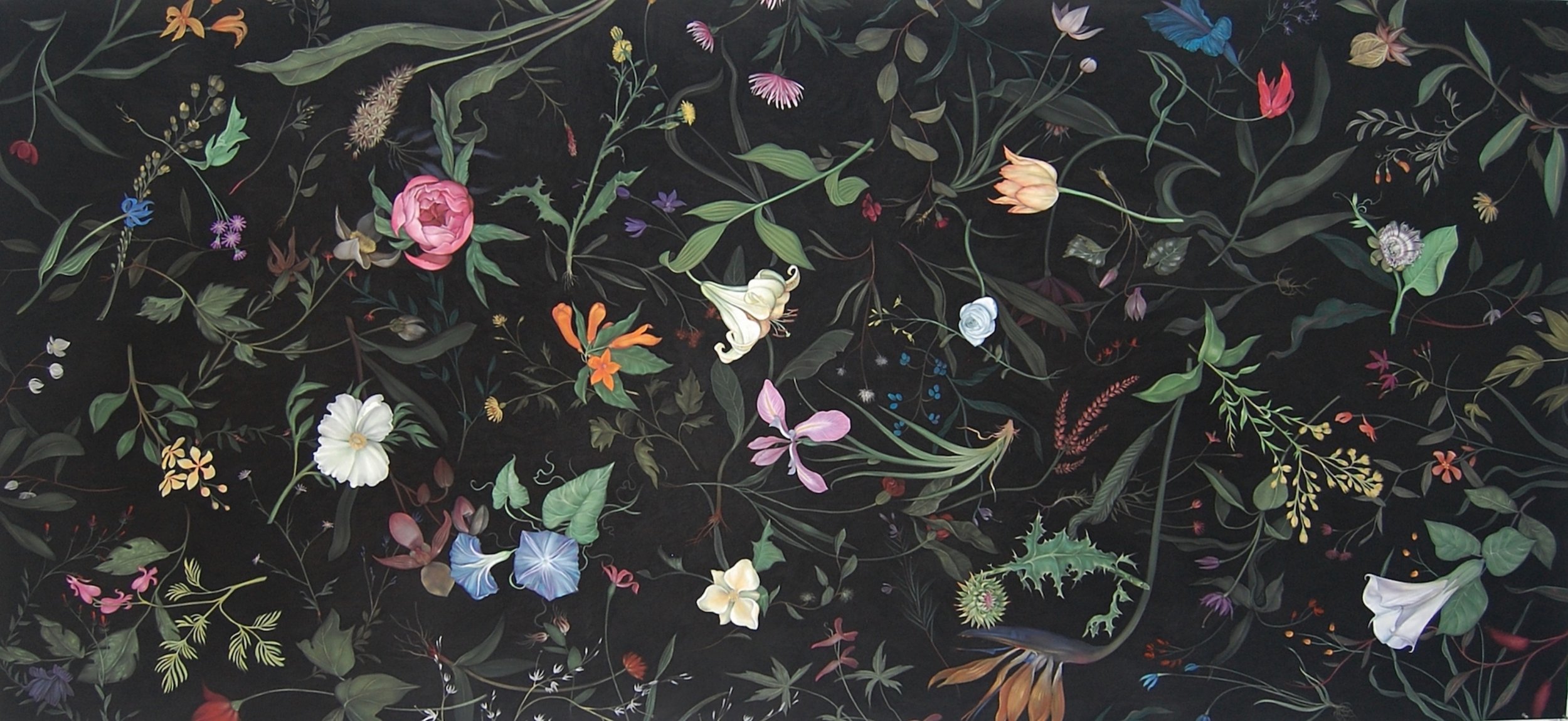Interview with Saskatchewan-Born and Based Artist and Curator Zachari Logan
Canadian artist and curator Zachari Logan’s mesmerising drawings portray bodies and flora melding into one another, harmoniously existing in moody, ethereal surroundings overgrown with intricately detailed greenery. I spoke to him after attending Lines in the Snow, a group exhibition he curated, to find out more about his practice and life. Taking place at New Art Projects in London, the UK, Lines in the Snow showcases a selection of impressive Canadian talent, with an offering of artworks that give a taste of the breadth that is contemporary drawing within a Canadian context. Zachari walks me through his life as an artist in Saskachewan, the inspirations he finds in neoclassical and romantic paintings and the political aspects of his works that are enfolded in the delicately drawn figures and shapes of his breathtaking works.
Spectre No. 1, Dead Flowers, pastel on black paper, 50x70 inches, 2022.
Sandy Di Yu: Can you give me an overview of how your practice has expanded and transformed in the years since you began creating art?
Zachari Logan: I did both my undergrad and my master’s at the University of Saskatchewan, which was not necessarily my intention. It was sort of ingrained into all of us who started off at Saskatoon to branch out and go do our master’s or further education at another institution. I actually did apply to a number of places and was conditionally accepted, but I ended up not going for financial reasons. The following year, I reapplied with what I thought was a better portfolio and I didn't get anywhere. Around then, Allison Norlen, whom I had worked with in my undergrad approached me and told me that there was an opening at the University of Saskatchewan, and they could offer me a full scholarship. I couldn't say no to this, even though my desire was to go to Montreal or Toronto. I hadn't even thought about anywhere international at that point.
Going to Saskatoon for my master’s was a great decision, as it turns out. I hadn’t exhausted everything that I could have learned from people like Allison, who ended up being the Chair of my program for a year.
I bring this all out because Saskatchewan can seem like a fairly isolated place within the context of Canada, even though there's a great arts community here, with a lot of wonderful artists working.
After my master's, I got a really great opportunity to show my work at a gallery in Paris. I had applied to have my work included in a drawing journal, and from that, this curator who had previously been working for the Rodin Museum opened up a commercial gallery with works on paper and invited me to do a solo show. So, all of the drawings that I did for my master’s show were then sent to Paris for this solo show, which was a great moment for me. It branched out in a way that I didn't think would happen, especially right out of a master's programme.
Around that time, I applied for a programme for recent MFA graduates, a prize called MFA Now, which is no longer around. I was one of the recipients, and my work was shown in a gallery in Miami. I had a lot of opportunities straight out of my master’s, which was really a propelling mechanism. I carried on showing with the gallery in Paris for a number of years and had another number of opportunities to show in New York and a series of residences that followed, one of which was going back to Paris myself, after realising that I was referencing all of these tropes and ideas in my own art were based on either romantic or neoclassical paintings that were displayed at the Louvre. With the help of the gallery that was showing my work, I got a nice grant and I went and just studied works in the Grand Hall in the Louvre, which became a feature of my practice.
One of the many things that have been so terrible about the pandemic is that physical interaction is completely shut off. I’m thankful for Zoom and I'm thankful for online programming, but art is such a physical experience. Going to a museum, I think I don't feel like I’ve ever taken that for granted, but even less so with the lockdowns. The online programming offered by art museums augmented but didn't make up for the experience.
Guardai in alto e vidi le sue Spalle, Rococo Sky, (detail) pastel, graphite, watercolour on blue paper, 50x540 inches, 2021.
Sandy: Was drawing always your main medium?
Zachari: Actually, in school, painting was my major. I was deeply influenced by Allison Norlen’s practice and the way that she worked on a large scale. It was also another experience of seeing really large scale pastel works in a show at the Musée d'Orsay in Paris and realising that I really can work on this scale and do what I want to do with this material. Painting for me just became laborious in a way that was not amenable to what I wanted any longer. I wanted to still work with colour and with references to historical painting, but I wanted to do it in drawing in a more immediate way. I started working with pastel just to see if I could get the same sort of thing. Pastel is a remarkable material. It's similar in a lot of ways in terms of its mixability and the quality of colour to oil. It was a gradual but natural shift from one material to the other.
Sandy: Could describe your process? How do you usually begin a piece? Do you have an idea in mind, or is there something that sparks inspiration immediately?
Zachari: Regardless of whether or not my body is present, my body is always the catalyst for new works. The body is always a focal point. I also find inspiration from our history, so it's one of the reasons why I like to travel and do a lot of residencies and just be in spaces and look at objects. Oftentimes, I describe it as having a conversation with a ghost because a lot of the work that I reference are artists who are long dead. If they are referenced in the work, their name ends up in the title of the work or a series of works. For instance, for the Unicorn Tapestries, I’d done a series of very large-scale drawings, one of which is in the National Gallery collection, called the Eunuch Tapestries, which is a reference to Unicorn Tapestries. It's unknown who made those works, which for me adds to the mystery of them, and the mystery of the narrative.
Mary Delany is a British paper artist from the 1700s, and I happened upon her work at the British Museum, where all of her works can be found. I became obsessed with her and read about her life. There are many other aspects other than the beauty of her work that led me to start referencing her practice and her life in my own work. I guess it's a process of contemporising things that I’ve seen and reworking them into a personal narrative.
Another reason why drawing is more appealing to me is its immediacy. There's nothing really between me and the materials. Especially with pastels, I'm working it onto the surface and then I’m rubbing it through with my fingers. I’ll often get to a certain point where I’ve rubbed my fingers raw, and they're bleeding and I have to let them callous over. It's very physically demanding but it's so linked to my body.
Eunuch Tapestry No. 5, (detail) pastel on black paper, 84x396 inches, 2016.
Sandy: I read in your bio on your website that it says, and I quote, “Logan rewilds his body as a queer embodiment of nature”, which I think is a really lovely turn of phrase. I was just wondering if you could expand on that a bit?
Zachari: In a way, it's an ecological stance, thinking about how my body affects the space that I’m in. Even thinking about why it is that I was born in the province of Saskatchewan when my family's history is in Scotland and how that implicates my body and my history in this sort of colonial project which is Canada, and trying to be simply mindful of this. My body being present in Saskatchewan suggests violence that I can't escape, nor do I want to. It needs to be acknowledged and talked about. It's a social and ecological stance, and I think in the work it's referenced through my body being present and physically morphing into landscape, whether that's plant or animal, or being represented as a dreamscape.
In relation to my own history, where I grew up, I had a great family and great friends, but it can be an isolating place for anyone, and for someone who is also queer, there were experiences that I had as a kid that were marginalizing. I started to think about the landscape of Saskatchewan as a marginal space, to begin with, but also seeking out spaces, where I could reclaim a sense of a queer space or queer embodiment, and I started thinking about the ditches that line the sides of the roads, in part because of my interest in weeds. This interest comes about primarily through how people talk about weeds and talk about discardable plants. Why is a weed, a weed? It's considered a weed because it has no purpose for human consumption, it has no reason by our social standards and resource needs to exist, so it's pushed to the side. A lot of people will come to Saskatchewan and think it’s this wide open, vast, untouched space, but so much of it has been manufactured for human consumption. The farmlands in the South, but also mining and other extractions in the North. That play on natural versus unnatural can relate to the social conversation about sexuality, where some sexuality is considered natural, and some are unnatural.
It also relates to the way we talk about weeds and the way we talk about differences in sexuality. Some sexualities are acceptable, they're fine, they work into the social structure of a heterosexual society, and some do not. There are those parallels between these particular plants that grow along the sides of the roads that are pushed to the side of the road and, for me it just became a really great metaphor for queer space and resilience on the margins.
Mouth No. 3, from Wildman Series, blue pencil on mylar, 12 x 16 inches, 2019.
Sandy: Did growing up and living in Canada inform your artistic vision?
Zachari: Yeah, so I grew up in Saskatoon and I grew up going to the Mendel Art Gallery, and I took classes there. My parents saw that I had an interest in art and a desire to pursue it from a young age, so I was very fortunate. They afforded me every opportunity that I could have in Saskatoon.
I always had the idea that I’d pursue art. I didn't exactly know how that was going to be. Then it came to graduating. A lot of friends and family have left the province or have done schooling outside of Canada and moved on. For me, when it comes to my studio practice, what I need is space and time, and I have an overabundance of that here. It’s still relatively reasonable for me to be a full-time artist and have a studio practice in terms of the cost of things. I have two studios, one that's primarily drawing and one where I do ceramics or painting. Because of the nature of my drawing materials, it gets on everything, so I have to have a full space dedicated to drawing.
I don't think I could afford the space and the time that I have here in, for example, Toronto, unless I was perhaps at a different point in my career. To maintain showing in other places and in other countries is quite helpful for me to be here, ironically enough.
Sandy: Could you speak more about your relations with the UK? You already mentioned the influences found at the British Museum, and also the fact that your family was in Scotland. Could you expand a bit more?
Zachari: I try to think back to the first time that I exhibited in London, which was also the first time I was in the UK. I was approached by a gentleman named William Angus-Hughes, and he had a really great gallery called Angus-Hughes Gallery in Lower Clapton in Hackney. He bought this three-story walk up and he had a studio in the basement, and he turned the main floor into a gallery space. It had Georgian windows at the front and Victorian windows at the back and it's just this really beautiful space that was white cube to a point, but still very domestic. He curated this show called Untitled Male and he included my work along with six other artists from the US and the UK.
Through that, I got a residency programme with William. He invited me back to do a solo show and to do some research. I had discovered Mary Delany on that trip, and I had started doing a series of drawings that ended up in the solo show at Angus-Hughes Gallery. That’s where I made contact with Fred Mann, who is the owner and director at New Art Projects. The current exhibition there, Lines in the Snow, is now our fourth project together.
Wreath No 3, Levitate (after Mary Delany), pastel on black paper, 50x65 inches, 2016.
Sandy: How did you go about selecting the artists for this show?
Zachari: The process of choosing the artists came down to me having known their work. There are so many remarkable artists working in drawing in Canada and this show was in no way exhaustible. It was just these 14 artists who I knew of. All of them minus one, I knew personally. Jutai Toonoo passed away unfortunately in 2015, so I knew of his work, but I did not know him personally.
It came from admiring their work and wanting to showcase their work in perhaps a place where it's unknown. One of the things that came out in the curatorial talk was that I said, you know, these are all household names in Canada in drawing, but I think hardly anyone at that talk was you know really aware of their practices.
Read our review of Lines in the Snow: Canadian Contemporary Drawing
For an artist or an art student or an artist story and in Canada, they would know most of those artists, like Wanda Koop, for example. Sometimes regionally you'll have artists that are really well known, but you mention their name in Toronto and people aren’t familiar with them. I definitely wanted to be mindful of including an artist from each region of Canada, or at least a very large geographical swath, which is very large considering we’re the second-largest country on the planet area wise. I did not end up including an artist from the maritime provinces, so that was one blind spot I was aware of it, but I didn't want to simply last-minute approach an artist. For this show, I did really want to limit it to artists who I had either done a studio visit with or knew personally or have shown with in the past and had that connection. I feel like it helps with the process of creating a dialogue, or a sort of story, which is kind of what curating is. In a group show, you're bringing together these different voices that are all very distinct, but perhaps through that process, you see connections. Which is what I was hoping for, and I think what I found.
Pool No. 2, after Mary Delany, pastel on black paper, 59x125 inches, 2017.
Sandy: Do you have any upcoming exhibitions or projects that will be taking place in the UK? What will you be working on next?
Zachari: I will have another show with Fred probably in the next year or two at New Art Projects and we’ll have to decipher when that will be. Besides that, I’m currently working on a project with a UK-based clothing brand called Old Age with whom I did a previous project. We developed a couple of designs from my drawings. The way that Old Age works is that they contact a visual artist to create one to five bespoke designs, usually for T-shirts, hoodies… just sort of casual wear. Neither I nor Old Age will make money off of this. The proceeds instead go to an arts organization. I chose Sâkêwêwak, which is a local indigenous art collective here in Regina. I'm doing another one with Old Age that will probably be launched in June between them and a US institution.
Other than that, my next major project is at the Peabody Essex Museum, which is in Salem, Massachusetts. It’s an exhibition called Remembrance. Then, I have a couple of other shows opening later in the year in Toronto.






